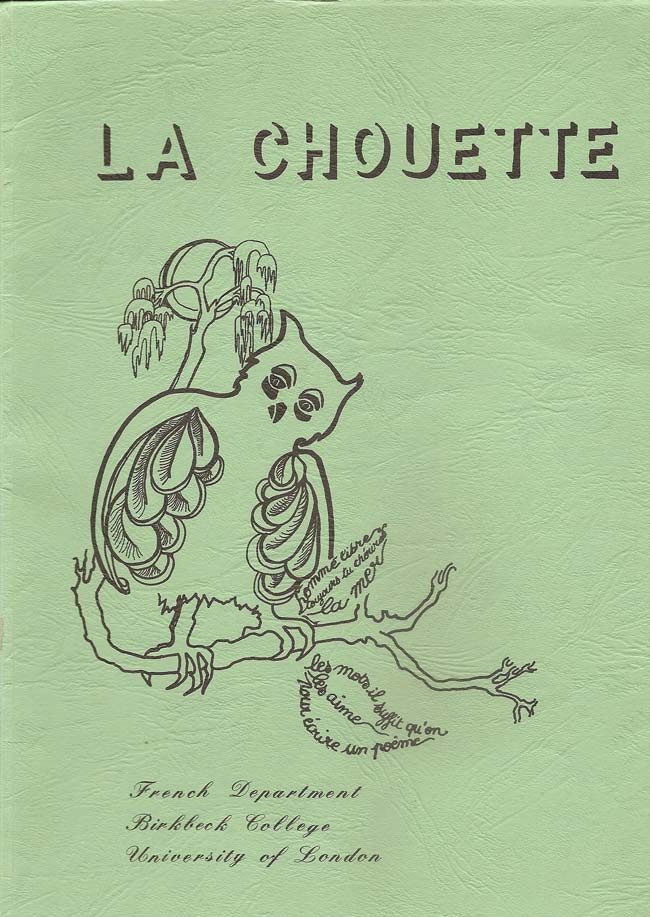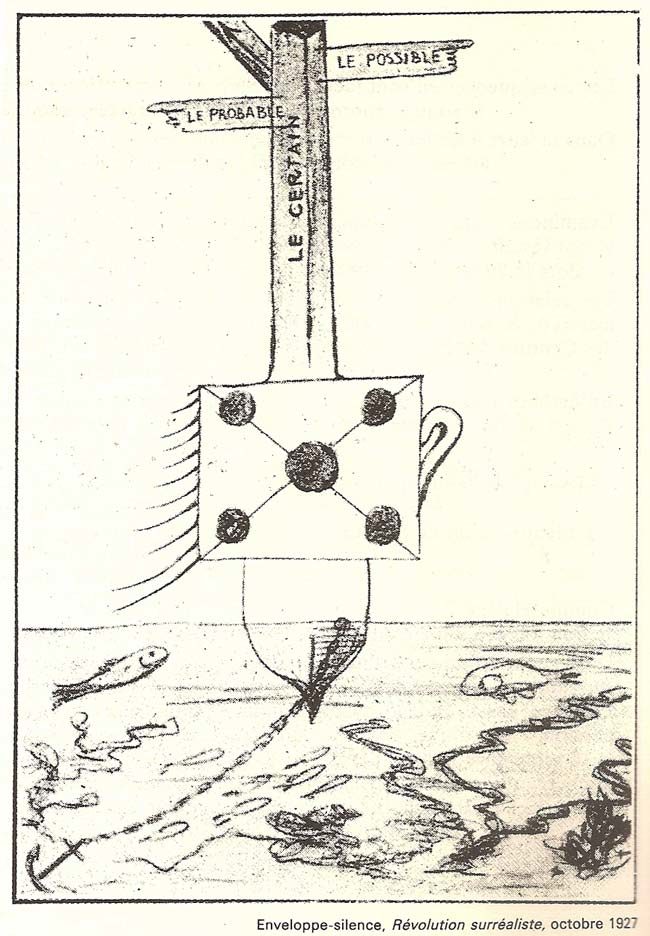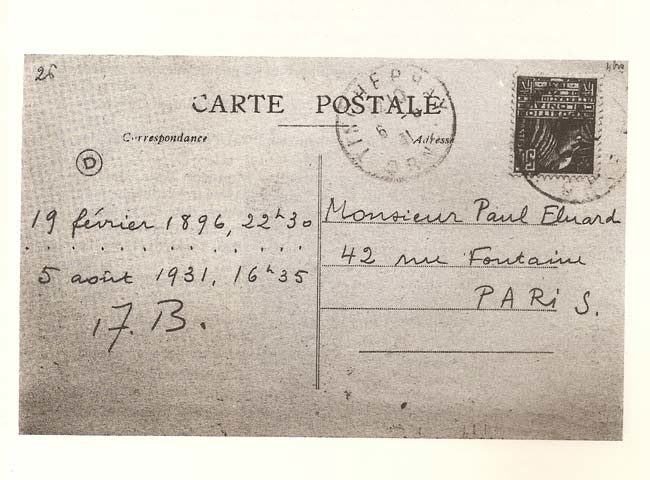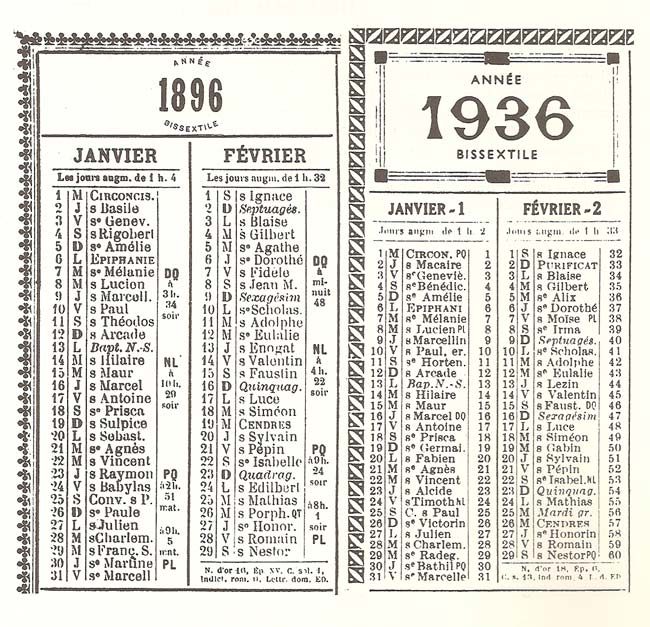
Georges Sebbag: L’Imprononçable jour de ma naissance: 17DRÉ 13RETON (Paris, Éditions Jean-Michel Place, 1988)
Georges Perec wondered what it wouId be like to write a life-story based exclusively on the bedrooms you had slept in, or the bus-tickets you had preserved, or your cheque-stubs. ln his later years Roland Barthes was fascinated with biography and what he called ‘un retour amical de l’auteur’, by which he meant the author in the text, conceived as ‘le lieu de quelques détails ténus’. And he expressed this touching wish:
Si j’étais écrivain, et mort, comme j’aimerais que ma vie se réduisît, par les soins d’un biographe amical et désinvolte, à quelques détails, à quelques goûts, à quelques inflexions, disons: des « biographèmes », dont la distinction et la mobilité pourraient voyager hors de tout destin et venir toucher, à la façon des atomes épicuriens, quelque corps futur, promus à la même dispersion; une vie trouée en somme…
Breton would have understood completely: if he once wrote ‘J’aimerais que ma vie ne laissât après elle d’autre murmure que celui d’une chanson de guetteur, d’une chanson pour tromper l’attente’ (L’Amour fou), he was apt to cherish, as particularly self-revealing, the products of this attitude of disponibilité. ln Nadja, having offered us some ‘biographèmes’ relating to Hugo and Flaubert, tiny anecdotes which seemed to reveal what he calls the ‘lumière propre’ of the individual, he tells us that he plans to relate
les épisodes les plus marquants de ma vie telle que je peux la concevoir hors de son plan organique, soit dans la mesure même où elle est livrée aux hasards… où elle m’introduit dans un monde comme défendu qui est celui des rapprochements soudains, des pétrifiantes coïncidences…
A few years later, in Point du jour, he observed:
La vérité particulière à chacun de nous est un jeu de patience dont il lui faut, entre tous les autres, et sans les avoir jamais vus, saisir les éléments au vol.

L’Imprononçable jour de ma naissance is a compendium of coincidences. ln sixty-five fragments, interspersed with an abundant visual accompaniment consisting of refreshingly unfamiliar facsimiles and photographs (Breton and his dog Melmoth, Suzanne Muzard at Saint-Cirq-la-Popie), Georges Sebbag plunges into the temporal flux of Breton’s existence. He is concerned not so much with events as with durées, with what he calls ‘le temps sans fil’ – the hidden intervals, spacings and periodicities which run beneath the surface of our existence marking out the innumerable parallel lives we lead.
Se défiant de la grosse ficelle du temps linéaire, Breton s’introduit dans le peu de réalité du temps sans fil.
Half-way through the book Sebbag explains that in 1984 he had just completed a philosophical essay entitled Le Temps sans fil, presumably a contribution to what one might call, the ‘Paraliterature of time’ which includes Jung’s work on synchronicity, Koestler’s (and Kammerer’s) meditations on ‘The roots of coincidence’, and J.W. Dunne’s famous Experiment with Time which Breton mentions once or twice. Wondering what to do next Sebbag picked up Breton’s Point du jour and found, to his astonishment, on the first page of the opening essay – the famous ‘Introduction au discours sur le peu de réalité’ – the phrase ‘sans fil’ which had preoccupied him for so long. Armed with the supposition that ‘Breton était habité par les durées’ he began an enquiry into the many references to specifie numbers and especially dates in Breton’s writings.
ln his ‘Introduction’ itself Breton had written:
L’auteur de ces pages n’ayant pas encore 29 ans et s’étant, du 7 au 10 janvier, date où nous sommes, contredit 100 fois sur un point capital, à savoir la valeur qui mérite d’être accordée à la réalité, cette valeur pouvant varier de 0 à ∞, on demande dans quelle mesure il sera plus affirmatif au bout de onze ans et 40 jours.
Sebbag calculates that this refers us to 19 February 1936, the date of Breton’s fortieth birthday, but also a year when the calendar was exactly the same as it was in 1896 (the year he was born): a repetition which occurs only every twenty-eight years (Breton’s age at the time of writing). Moreover, in 1936 as in 1896 Breton’s birthday fell on a Wednesday. (This is also the case in 1931 when, on his only visit to his birthplace, Tinchebray, Orne, Breton sent Eluard a postcard, reproduced here – the postcard was similarly sent on a Wednesday, though in August.)


Breton will also die on a Wednesday in 1966, and this day of the week crops up regularly in his work. So do Saturdays. Breton’s twentieth birthday, commemorated in the poem ‘Age’, fell on a Saturday, as does 10 January 1925 (see above). This is also the day of the week on which Jacques Vaché was born, and Breton buried. The odd thing is that at a point in the early thirties Breton began to say both in print and in private that he was born on 18 February (not 19 February), on a Tuesday not a Wednesday, that he was an Aquarius not a Pisces. The first explicit written occurrence is in the ‘prière d’insérer’ for Point du jour (1934). Sebbag, though, ever on the alert, finds something fishy about a series of dates Breton cites in Les Vases communicants (1932) where three consecutive days in 1931 (20, 21, 22 April) are said at different points to be ‘Mardi’. Now, in the year Breton was born, 19 February (his real or ‘official’ birthdate) was Ash Wednesday, while the Tuesday (his adopted birthday) was Mardi Gras. For our sleuth this means we should link the shift of weekday to the growth of the ‘lutte antireligieuse’ among the surrealists in the early thirties. Moreover, the ascendancy of Tuesdays is triumphantly affirmed in L’Amour fou where the ‘scène de l’Ondine’, the unforgettable ‘Nuit du Tournesol’ and the poet’s marriage to Jacqueline all occur on this day of the week. ln another essay in Point du jour Breton had commented on the uncertainties which surround Achim von Arnim’s birthdate. Nowadays one might want to link Breton with Samuel Beckett who also seems to have chosen to refashion his birthdate for symbolic reasons, opting in his case for Good Friday.
All this (and l have only given a taste of the book’s contents and concerns) may seem trivial or worse, tedious. It is certainly often very hard to follow (especially for the less numerate), despite Sebbag’s unpretentiously lively and unfacetious style. What makes the book attractive, though, is its acute sensitivity to a cluster of things which, l suspect, Breton’s readers often cherish in his work. From Nadja onwards Breton traced with singular pertinacity what one might call the trajectories of desire, sifting ‘aussi bien quelques-uns des faits à première vue les plus humbles que les plus significatifs de ma vie’ for the ‘lumière de l’anomalie’ they seemed to emit, confident in his belief, derived and adapted from Freud, that the life of the unconscious repeatedly manifests itself in the nooks and crannies of our day-to-day lives, revealing not merely the symptoms of neurosis but the force of desire to transmute the reality most people settle for. This means that Breton’s books (including the poems) are full of odds and ends, strange incidents, stray utterances, circumstantial details, ‘figurants’ as well as leading players. Sebbag’s book is full of this lore. School is out: we are spared the ‘studium’ of critical analysis, and offered the staccato Jouissances of the ‘punctum’. Never mind the genealogy of Hasard objectif. How about the links between the ‘sans fil’ of the Introduction and the first Manifeste, the typographical poem ‘ILE’ in Clair de terre, and the message from the ‘Ile du sable’ which comes over the ‘sans fil’ at the end of Nadja? Or how about the hidden threads which link the words ‘Aube, adieu’, in the early poem ‘Age’, the restaurant signboard ‘Les Aubes’, depicted in the second edition of Nadja, marking a crucial moment in Breton’s relationship with Suzanne Muzard, the latter’s birthplace: Aubervilliers, where Breton also lived as a chiId, La Ferté Saint-Aubin, a name which Breton once tells us he forgot, and the name of the poet’ s daughter, Aube, born in 1935? What of the name ‘Béthune’ which suddenly came into Breton’s head on 8 June 1924? How does it connect with Milady de Winter in Les Trois Mousquetaires, with images of decapitation in Breton, with the poem ‘La Porte bat’ which seems to draw on Dumas’s Vingt ans après? And the date 1713 which Breton divined in the initials of his name: where can it take us?
There are two sorts of cryptologist: there is the fanatical crank utterly persuaded that he alone has found, let us say, the meaning of ‘Voyelles’; then there is the enthusiast who wants us to participate in a ludic (but also serious) opening-up of texts he loves: this kind of cryptologist (and Sebbag is one) is a poet, and a guide whose obsession is worth sharing, for a while at least (that is all he asks). ‘Psychanalyse sauvage’? ‘Délire d’interprétation’? Perhaps. Yet there is something infectious about Sebbag’s appetite for the ‘entrées et sorties des textes’, the permeability and permutability of experience. Not only does he pay tribute to something vital in Breton which ‘criticism’ is ill at ease with, but he contributes to our thoughts about what biography might become were it to wean itself of the ‘grands récits’ to which it is still generally addicted. Let us give Sebbag the last word:
En dédoublant le jour de sa naissance, Breton s’introduit dans le film des durées. Il profane le Mercredi des Cendres et placarde le Mardi des Masques. Il met en scène les aubes, les apparitions du temps, les boys du sévère. Il écrit le discours qui a une portée, celui du peu de réalité.
Michael Sheringham
University of Kent
Références
Michael Sheringham, « Le film des durées », La Chouette, n° 21, mars 1989, French Department, Birbeck College, University of London.